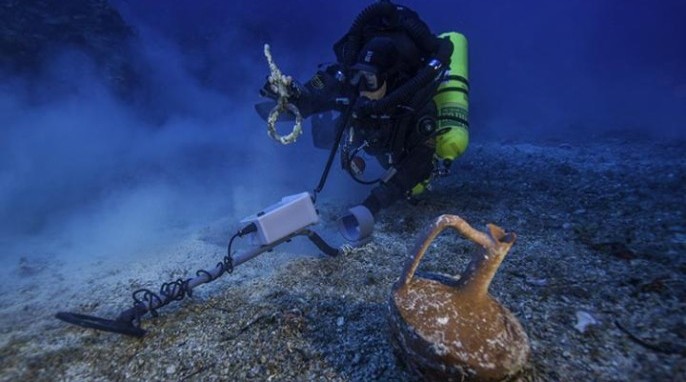Underwater Archaeology, Ancient Shipwreck
An underwater archaeology team has retrieved new finds from an ancient Greek ship that sank over 2,000 years ago.
An international team of divers and archaeologists has retrieved amazing new finds from an ancient Greek ship that sank more than 2,000 years ago. Because of its large size and luxury cargo, they are calling this ship the “Titanic of the ancient world.”
The Antikythera wreck was first discovered in 1900 by sponge divers who were blown off course by a storm. They subsequently recovered a spectacular haul of ancient treasure including bronze and marble statues, jewelry, furniture, luxury glassware, and the surprisingly complex Antikythera Mechanism (an ancient analog computer). Their work at the 55-meter-deep site came to an end after one diver died of the bends and two were paralyzed. Ever since, archaeologists have wondered what remains buried beneath the sea bed.
RELATED: Archaeologists at Ancient Roman Gold Mines
Now, and underwater archaeology team including Brendan Foley of the Woods Hole Oceanographic Institution and Theotokis Theodoulou of the Hellenic Ephorate of Underwater Antiquities have returned to this dangerous archeological site. The wreck is too deep to explore safely with regular scuba equipment, so the divers used rebreather technology, in which carbon dioxide is scrubbed from the exhaled air while oxygen is introduced and recirculated. This allowed them to dive on the site for up to three hours at a time.
This month, the underwater archaeology team has created a high-resolution, 3D map of the wreck and discovered that much of the ship’s cargo is indeed still preserved beneath the sediment on the sea floor. Even after 2,000 years, much of the ancient ship survives. Among the cargo, archaeologists have recovered an intact lagynos table jug, part of an ornate bed leg, and a two-meter-long bronze spear. Too large and heavy to have been used as a weapon, it may have belonged to a giant statue.
RELATED: 3D Model Used to Recreate King Richard III’s Grave
The team has found parts of the ship including massive hull planks, lead anchors over a meter long, and a bronze rigging ring with fragments of wood still attached.
The overall size of the wreck site, along with the huge size of the anchors and recovered hull planks, suggests that the Antikythera ship was much larger than previously thought, perhaps up to 50 meters long. “The evidence shows this is the largest ancient shipwreck ever discovered,” says Foley. “It’s the Titanic of the ancient world.”
The shipwreck dates from 70 to 60 BC and is thought to have been carrying a luxury cargo of Greek treasures from the coast of Asia Minor west to Rome. Antikythera stands in the middle of this major shipping route and the ship probably sank when a violent storm smashed it against the island’s sheer cliffs.
The underwater archaeology team plans to return next year to excavate the site further and recover more of the ship’s precious cargo. The finds, particularly the bronze spear, are “very promising,” says Theodolou. “We have a lot of work to do at this site to uncover its secrets.”
RELATED: Prehistoric Human Settlements at the Bottom of the Sea
Image: Greek technical diver Alexandros Sotiriou discovers an intact ceramic table jug and a bronze rigging ring on the Antikythera Shipwreck. (Brett Seymour, Return to Antikythera 2014)




